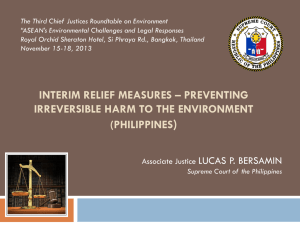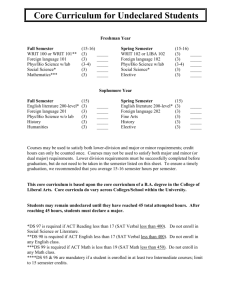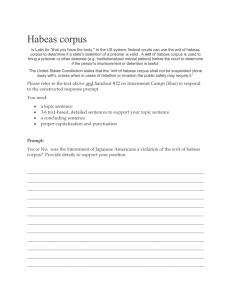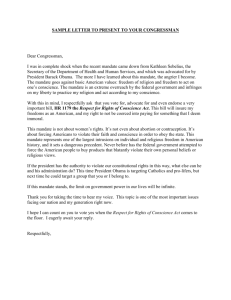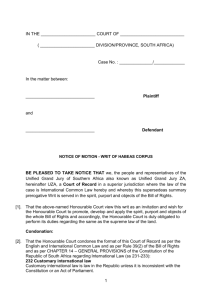In MS Word - Law Library for San Bernardino County
advertisement
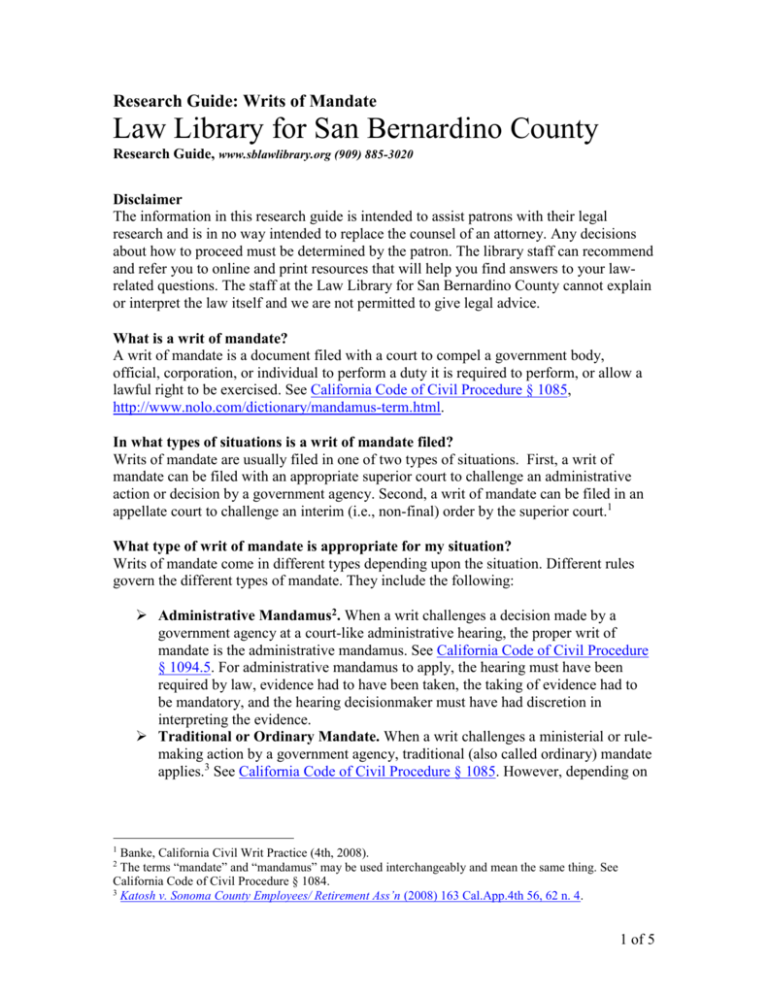
Research Guide: Writs of Mandate Law Library for San Bernardino County Research Guide, www.sblawlibrary.org (909) 885-3020 Disclaimer The information in this research guide is intended to assist patrons with their legal research and is in no way intended to replace the counsel of an attorney. Any decisions about how to proceed must be determined by the patron. The library staff can recommend and refer you to online and print resources that will help you find answers to your lawrelated questions. The staff at the Law Library for San Bernardino County cannot explain or interpret the law itself and we are not permitted to give legal advice. What is a writ of mandate? A writ of mandate is a document filed with a court to compel a government body, official, corporation, or individual to perform a duty it is required to perform, or allow a lawful right to be exercised. See California Code of Civil Procedure § 1085, http://www.nolo.com/dictionary/mandamus-term.html. In what types of situations is a writ of mandate filed? Writs of mandate are usually filed in one of two types of situations. First, a writ of mandate can be filed with an appropriate superior court to challenge an administrative action or decision by a government agency. Second, a writ of mandate can be filed in an appellate court to challenge an interim (i.e., non-final) order by the superior court.1 What type of writ of mandate is appropriate for my situation? Writs of mandate come in different types depending upon the situation. Different rules govern the different types of mandate. They include the following: Administrative Mandamus2. When a writ challenges a decision made by a government agency at a court-like administrative hearing, the proper writ of mandate is the administrative mandamus. See California Code of Civil Procedure § 1094.5. For administrative mandamus to apply, the hearing must have been required by law, evidence had to have been taken, the taking of evidence had to be mandatory, and the hearing decisionmaker must have had discretion in interpreting the evidence. Traditional or Ordinary Mandate. When a writ challenges a ministerial or rulemaking action by a government agency, traditional (also called ordinary) mandate applies.3 See California Code of Civil Procedure § 1085. However, depending on 1 Banke, California Civil Writ Practice (4th, 2008). The terms “mandate” and “mandamus” may be used interchangeably and mean the same thing. See California Code of Civil Procedure § 1084. 3 Katosh v. Sonoma County Employees/ Retirement Ass’n (2008) 163 Cal.App.4th 56, 62 n. 4. 2 1 of 5 the situation, a party may be entitled to both administrative and ordinary mandate.4 Writ of Mandate to an Appellate Court. This type of mandate generally applies when a party seeks to have an appellate court overturn an interim order by a superior court. An “interim order” is an order entered by a court prior to the final order or judgment in the case.5 How long do I have to file a writ of mandate? The deadline for filing a writ of mandate varies depending on the situation. Sometimes, a specific deadline applies, including challenges to property development restriction decisions (see Government Code §§ 66499.37, 65009(c) – 90 days), and petitions under the California Environmental Quality Act (see Public Resources Code §§ 21167 – varies depending upon nature of challenge).6 Review the code governing the government agency whose decision you wish to challenge to see if a specific deadline applies. Also see, California Administrative Mandamus, ch. 9, KFC 782 .D43 (available at all branches, in print and online through CEB OnLaw), for a detailed discussion and list of applicable deadlines. Where no specific deadline applies, the statute of limitations for the type of right the writ of mandate seeks to enforce determines the filing deadline.7 See Code of Civil Procedure §§ 312-366.3. A 60-day deadline applies to writs of mandate filed in the appellate court to challenge a superior court order. See Cal W. Nurseries, Inc. v. Superior Court (2005) 129 Cal.App.4th 1170, 1173, Rule of Court 8.104.8 How does a writ of mandate proceeding work? A writ of mandate proceeding in the superior court may take one of two forms: a noticed motion, or the “alternative writ procedure.” You should consult the local court rules for the superior court in which you are filing, and the court clerk, to see which type of proceeding is preferred in your court. Under the noticed motion type9: o A writ of mandate proceeding under this type begins by filing the writ petition with the appropriate superior court. For forms for filing a writ of mandate petition, see “Forms for Writs of Mandate at the San Bernardino County Law Library,” below. o The writ is then served on the respondent (the party against whom the writ is sought), and any real parties in interest (for example, the owner of the real property that is the subject of the writ). o After that, a motion is set, and the parties are given an opportunity to argue the case at a hearing. See “What is a Motion?” research guide at 4 Mileikowsky v. Tenet Healthsystem (2005) 128 Cal.App.4th 531, 554. Banke, California Civil Writ Practice (4th, 2008), § 17.23. 6 Id., § 5.72. 7 Id. 8 Id., § 5.73. 9 Id., § 5.10. 5 2 of 5 http://www.sblawlibrary.org/research-guides--self-help-info.html for information on motion procedure. At the hearing, the judge makes his/her decision to either grant or deny the writ. Under the alternative writ procedure10: o This procedure begins by filing the writ petition with the court, and on the same day, appearing before the court on an “ex parte” basis. See http://sandiegolawlibrary.org/wp-content/uploads/2012/05/ExParte_Applications1.pdf, for information on ex parte hearings. o At the hearing, the court will decide whether or not to issue the “alternative” (i.e., preliminary) writ. If the alternative writ is issued, dates will be set by which the respondent and any real party in interest must file their return(s) (responses) on the writ, and a date will be set for a final hearing. The writ must then be served on the respondent and any real party in interest. o At the final hearing, the court will decide whether to grant or deny the writ. For a writ of mandate to an appellate court, the rules and procedures for an appeal generally apply. See California Practice Guide: Civil Appeals and Writs, KFC 1075 .E47 (available at San Bernardino branch, in print, and online at all branches through Westlaw), or California Civil Writ Practice, KFC 1070 .C35, volume 2 (available at San Bernardino and West End branches, in print, and online at all branches through CEB OnLaw). How will the court decide whether or not to grant my writ of mandate? In addition to the arguments and pleadings of the parties, the court will also rely upon the record of the proceeding from the government agency or corporate body (or superior court, if the writ is sought against the superior court). It is the petitioner’s responsibility to provide the superior court (or appellate court) with this record. See California Civil Writ Practice, KFC 1070 .C35, ch. 7. Selected Statutes and Rules Concerning Writs of Mandate Statute/Rule Code of Civil Procedure § 1085 Code of Civil Procedure § 1086 Code of Civil Procedure § 1087 Code of Civil Procedure § 1088 Code of Civil Procedure § 1088.5 Code of Civil Procedure § 1090 10 Description Courts which may issue writ; parties to whom issued; purpose of writ Circumstances authorizing issuance; petition Contents; alternative writ; peremptory writ Issuance of writ in first instance; form; notice; service; hearing required Application; proof of service of petition Jury trial; discretion; order for trial Id., § 5.15. 3 of 5 Code of Civil Procedure § 1094 Code of Civil Procedure §§ 1094.5-1094.8 Code of Civil Procedure § 1096 Code of Civil Procedure §§ 1107-1110b San Bernardino County Superior Court Local Rules 540, 730.2 Code of Civil Procedure §§ 307-1062.20 Rules of Court 2.1-2.1100 Hearing Administrative mandamus Service General rules pertaining to mandate Civil writs General rules of pleading and practice in civil cases (made applicable to writ proceedings by C.C.P. § 1109, except where provided otherwise) Trial court rules (apply to all cases in superior court per CRC 2.2, 3.1100, 3.1103(a)(2)) Selected Forms for Writs of Mandate at the San Bernardino County Law Library There are currently no Judicial Council Forms specifically pertaining to writ of mandate proceedings. Consult one or more of the “Resource Guides for Writs of Mandate” listed below for a full list of all documents that must be filed with the court. This list only includes the primary forms you may need. California Forms of Pleading and Practice, Matthew Bender & Co., KFC 1010.A65 C3, available at all branches, in print, and online through Lexis. o § 358.130: Basic Form of Petition to Superior Court in Special Proceeding for Writ of Mandate or Prohibition o § 358.138: Basic Form of Petition to Appellate Court in Special Proceeding for Writ of Mandate or Prohibition California Points and Authorities, Matthew Bender & Co., KFC 1010 .C34, available at San Bernardino branch, in print, and online at all branches through Lexis. o § 150.30: Supporting Petition for Writ of Mandate (Code Civ. Proc. §§ 1085, 1086)--Skeletal Form o § 150.39: Supporting Contention That Writ of Mandate Is Necessary to Compel Action by Public Entity or Official--Duty of Public Entity or Official to Perform Mandatory Ministerial Act o § 150.40: Supporting Contention That Writ of Mandate Is Necessary to Compel Action by Public Entity or Official--Duty of Public Entity or Official to Instate Petitioner to Office or Employment o § 150.45: Supporting Contention That Writ of Mandate Is Necessary to Compel Action by Lower Court--Direct Appeal Is Inadequate Legal Remedy o § 150.160: Supporting Contention That There Is No Plain, Speedy, and Adequate Remedy in Ordinary Course of Law--General Form 4 of 5 Resource Guides for Writs of Mandate at the San Bernardino County Law Library California Civil Writ Practice (4th ed.), Kathleen M. Banke, et al., KFC 1070 .C35, available at San Bernardino and West End branches, in print, and online at all branches through CEB OnLaw. California Administrative Mandamus (3rd ed.), Michael E. Abbott, et al., KFC 782 .D43, available at all branches, in print and online through CEB OnLaw. California Practice Guide: Civil Appeals and Writs, Jon Eisenberg, et al., KFC1075 .E47, available at San Bernardino branch, in print, and online at all branches through Westlaw. (This practice guide covers writs of mandate to an appellate court only.) California Forms of Pleading and Practice, Matthew Bender & Co., KFC 1010.A65 C3, available at all branches, in print, and online through Lexis. o Ch. 358: Mandate and Prohibition California Points and Authorities, Matthew Bender & Co., KFC 1010 .C34, available at San Bernardino branch, in print, and online at all branches through Lexis. o Ch. 150: Mandate and Prohibition California Practice Guide, Civil Procedure Before Trial, Robert I. Weil, et al., KFC 995 .W4, available at San Bernardino and West End branches, in print, and at all branches online through Westlaw. (This practice guide covers civil procedure and practice in general, and can be used for information on motions and ex parte hearings generally.) Links for Writs of Mandate: San Diego Law Library Research Guide on Writ of Administrative Mandamus: http://sandiegolawlibrary.org/wpcontent/uploads/2013/04/Writ_of_Administrative_Mandamus.pdf California Code of Civil Procedure http://codes.lp.findlaw.com/cacode/CCP/ or http://leginfo.ca.gov/calaw.html Judicial Council's Official Court Forms http://www.courtinfo.ca.gov/forms/ Terms used in this Guide can be looked up by using Black’s Law Dictionary in the library or by using Nolo’s plain law dictionary at http://www.nolo.com/dictionary/. 5 of 5
